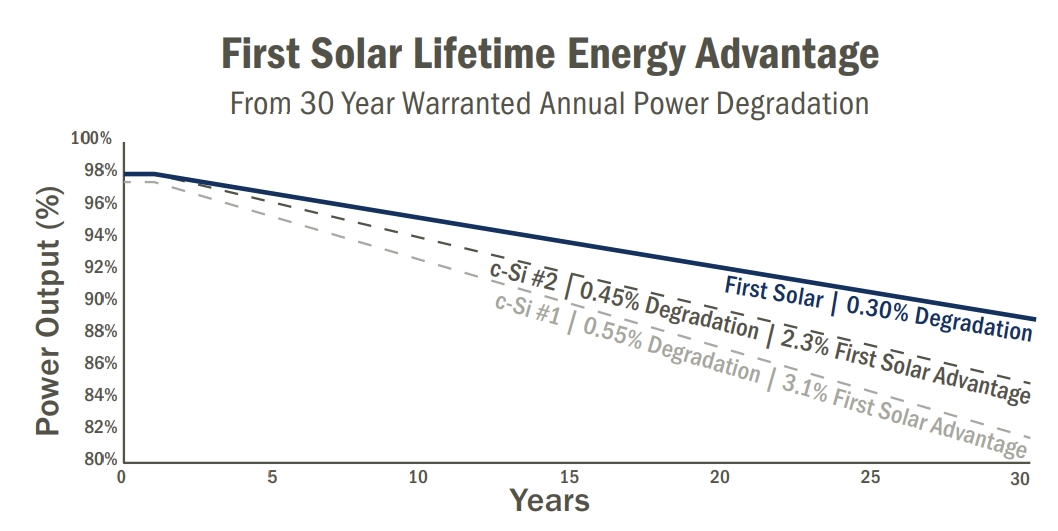Sürdürülebilirlik
AI Advances Thin-Film Solar by Unlocking Perovskite Stability
Securities.io titiz editoryal standartlarını korur ve incelenen bağlantılardan tazminat alabilir. Kayıtlı bir yatırım danışmanı değiliz ve bu bir yatırım tavsiyesi değildir. Lütfen şuraya bakın: bağlı kuruluş açıklaması.

From Silicon To Thin Films
Makalemizde "Güneş Çağı – İnsanlık İçin Parlak Bir Gelecek“, we explained how the rise of solar energy was ushering in a revolution in our energy supply, at least in the long term.
Şu ana kadar üretilen güneş panellerinin yaklaşık %90'ı silikon bazlı teknoloji kullanılarak üretilirken, büyük çoğunluğu eski monokristal silikon tasarımların yerini alan polisilikon tasarımları kullanıyor (monokristal silikon daha dayanıklıdır ancak aynı zamanda daha az maliyet etkindir).

Kaynak: ÇED
An alternative is perovskites, also often called thin-film solar cells, which capture the Sun’s energy thanks to the unique crystalline structure of perovskite. (Another form of thin film solar technology uses cadmium telluride thin film cells.)
İnce film terimi, elektrik üretmek için gereken çok daha ince malzeme tabakasından gelir ve bu da güneş hücrelerinin daha esnek ve hafif olmasını sağlar.
Doğal olarak oluşan perovskitler kalsiyum ve titanyum oksitten (CaTiO3) oluşur, ancak diğer mineraller de “ABX3” kuralını izleyen bir kimyasal formülle aynı kristal yapıya sahip olabilir.
While very high in their energy conversion yield, perovskites are less durable than silicon solar cells, which have hindered practical use and their commercial adoption.
Researchers at the Chalmers University of Technology (Sweden) and the University of Birmingham used machine learning to clarify the missing part of theoretical knowledge about perovskite crystal structure, opening the way to make them more durable, and therefore, maybe the next generation of commercial photovoltaic technology.
They published their results in the Amerikan Kimya Derneği Dergisi1, Başlığın altında "Revealing the Low-Temperature Phase of FAPbI3 Using a Machine-Learned Potential anlayışının sonucu olarak, buzdolabında iki üç günden fazla durmayan küçük şişeler elinizin altında bulunur.
Formamidinium Perovskite Stability
The researchers worked with a material called formamidinium lead iodide (FAPbI3). It is considered one of the best-performing materials in the halide perovskite group for its promising properties for future solar cell technologies.
However, the material is generally not stable enough under sunlight for commercial application, and part of the reason is that the low-temperature phase of formamidinium lead iodide remains poorly understood, until now.
“The low-temperature phase of this material has long been a missing piece of the research puzzle and we’ve now settled a fundamental question about the structure of this phase.”
Advanced AI Modeling
Experimental observations had so far not been enough to understand the FAPbI3 crystal structure. Traditional computer simulations, trying to calculate and simulate the behavior of the atoms one by one, require powerful supercomputers and long simulation times.
Instead, the researchers used their expertise in machine learning to drastically improve the efficiency of computer simulation.
“By combining our standard methods with machine learning, we’re now able to run simulations that are thousands of times longer than before.
And our models can now contain millions of atoms instead of hundreds, which brings them closer to the real world,”
Crystal Phase Transitions in FAPbI3
Depending on temperature, FAPbI3 can take different crystal structure: cubic at 300°K (27°C / 80°F), tetragonal below 285°K (12°C / 53°F) and still unknown at 140°K (-133°C / -207°F)

Kaynak: Amerikan Kimya Derneği Dergisi
They found that their simulation predicted that the material can be put into a semi-stable state when cooled.
They then tested it in real life -200 °C / -328°F, to confirm that the simulation accurately predicts the behavior of perovskite crystals, especially in this yet unproven condition.
The model mostly worked with almost perfect prediction for the movement of carbon atoms, and an accurate enough prediction for nitrogen atoms.

Kaynak: Amerikan Kimya Derneği Dergisi
Applications of AI-Powered Perovskite Research
This model is the first one to predict with good accuracy all the crystal structures of this perovskite material. It is also a lot less intensive in terms of compute requirements, making it usable by almost any research team in the world. So it might drastically speed up the progress of this technology.
Crystal structure and their stability are the keystones to make perovskite more durable, and so is also key to making them commercially viable.
“We hope the insights we’ve gained from the simulations can contribute to how to model and analyse complex halide perovskite materials in the future,”
Thin-film solar, being more flexible, can be deployed in many more contexts than traditional solar panels. They are also a lot lighter in weight.
So if perovskite can be used commercially, we could start using it on the surface of buildings, cars, rooftops, cell phones, etc, providing abundant energy without the need for dedicating land to large solar farms.
Amidimium seems the right direction for this technology, with other reports also indicating that a protective coating of amidimium can radically increase the life span of thin film solar cells. Alumina nanoparticles could also boost perovskite solar cell lifespan 10x.
Most likely, a combination of several of these technologies will emerge to create an ultra-durable thin-film perovskite solar cell.
Kaydırmak için kaydırın →
| Teknoloji | Malzeme | Verimlilik Potansiyeli | dayanıklılık | Ticari Hazırlık |
|---|---|---|---|---|
| Silicon (mono/poly) | Kristalin silikon | 22-26% | Very high (25–30 years) | Fully commercial |
| Kadmiyum Tellür | CdTe thin-film | 23-25% | High (30 years, 89% retention) | Commercial (First Solar) |
| Perovskite (FAPbI3, amidinium) | Halide perovskitler | >30% (lab-scale tandem) | Currently low (degrades under sunlight) | Pre-commercial, research stage |
Investing in Solar Innovation
İlk Güneş, Inc.
İlk Güneş, Inc. (FSLR + 0.36%)
First Solar, ABD, Malezya ve Vietnam'daki üretim tesisleriyle ABD'nin ve tüm Batı yarımkürenin en büyük güneş paneli üreticisidir.
Şirket klasik kristalin silikon teknolojisini kullanmıyor; bunun yerine kullanıyor tescilli ince film fotovoltaikleri.
Based on cadmium-telluride, they are more efficient, are produced at a lower cost, and can easily be mass-manufactured.

Kaynak: Enerji Bölümü
Cadmium telluride thin-film solar panels are also more durable, retaining 89% of the original performance after 30 years.

Kaynak: First Solar
Kadmiyum ve tellür, diğer metallerin madenciliğinin yan ürünleridir; bu, First Solar ürünlerinin daha önce çok az kullanılan kaynakları kullanarak minimum etkiye sahip olduğu anlamına gelir. İnce film paneller de yüksek bir geri dönüşüm oranına sahip olabilir.
The company’s focus on thin-film semiconductor technology allows it to be fully vertically integrated, making it radically different from the silicon-based solar panel industry.
Polisilikon saflaştırma gibi tek bir segmentte uzmanlaşmış birden fazla fabrika ve bir güneş hücresi üretmek için günlerce uğraşmak yerine, First Solar ham maddeden bitmiş ürüne 4 saatten kısa sürede ulaşabiliyor.

Kaynak: First Solar
First Solar’s technological edge, combined with its geographical location, makes it the likely beneficiary of the growing push for Western countries to source their panels from outside China.
Şirket, üretim kapasitesini hızla artırıyor ve 25 yılına kadar mevcut 2026 GW'lık nominal kapasiteyi 11 GW'a çıkarmayı hedefliyor.
First Solar has spent a cumulative $2B in R&D since its inception. R&D teams at First Solar forecast a thin film CdTe of 25% cell efficiency and pathways to 28% cell efficiency by 2030.
Considering its involvement in the research discussed here, the company is also clearly interested in perovskite, at least as soon as these panels are durable enough.
First Solar, uzun vadede kadmiyum tellür ince film konusundaki deneyimini perovskit teknolojisiyle birleştirerek ortaya çıkan güneş panellerini daha da verimli hale getirmeyi hedefliyor.

Kaynak: First Solar
Genel olarak First Solar, Çin ithalatına uygulanacak gümrük vergilerinden faydalanabilecek bir teknoloji lideri konumunda. Bu durum, Trump'ın yeniden seçilmesinin güneş enerjisi sektöründe yarattığı olumsuz etkiyi telafi edebilir.
While mostly focused on thin-film solar using cadmium telluride for now, its expertise in non-silicon solar panel manufacturing could give it a significant head start with perovskite, especially considering its deep ties to some of the top researchers in this field.
(Ayrıca okuyabilirsiniz more information about First Solar in the investment report dedicated to the company)
En Son First Solar (FSLR) Hisse Senedi Haberleri ve Gelişmeleri
First Solar (FSLR) Piyasanın Üzerinde Yükseliyor: Önemli Gerçekler
First Solar: Solar Made In US Meets AI-Driven Load Growth
En Çok İzlenen Hisse Senedi First Solar, Inc. (FSLR) Şu Anda Bahse Girmeye Değer mi?
First Solar (FSLR) Piyasa Getirilerini Aştı: Dikkat Edilmesi Gereken Bazı Gerçekler
First Solar to Ride the High-Tech PV Module Wave With Its CuRe Program
İlk Güneş Enerjisini Alıp, Texas Instruments'ı Satmak mı?
Referans Verilen Çalışma
1. Sangita Dutta, Erik Fransson, Tobias Hainer, Benjamin M. Gallant, Dominik J. Kubicki, Paul Erhart, and Julia Wiktor. Revealing the Low-Temperature Phase of FAPbI3 Using a Machine-Learned Potential. Amerikan Kimya Derneği Dergisi. Ağustos 14, 2025. https://pubs.acs.org/doi/10.1021/jacs.5c05265













